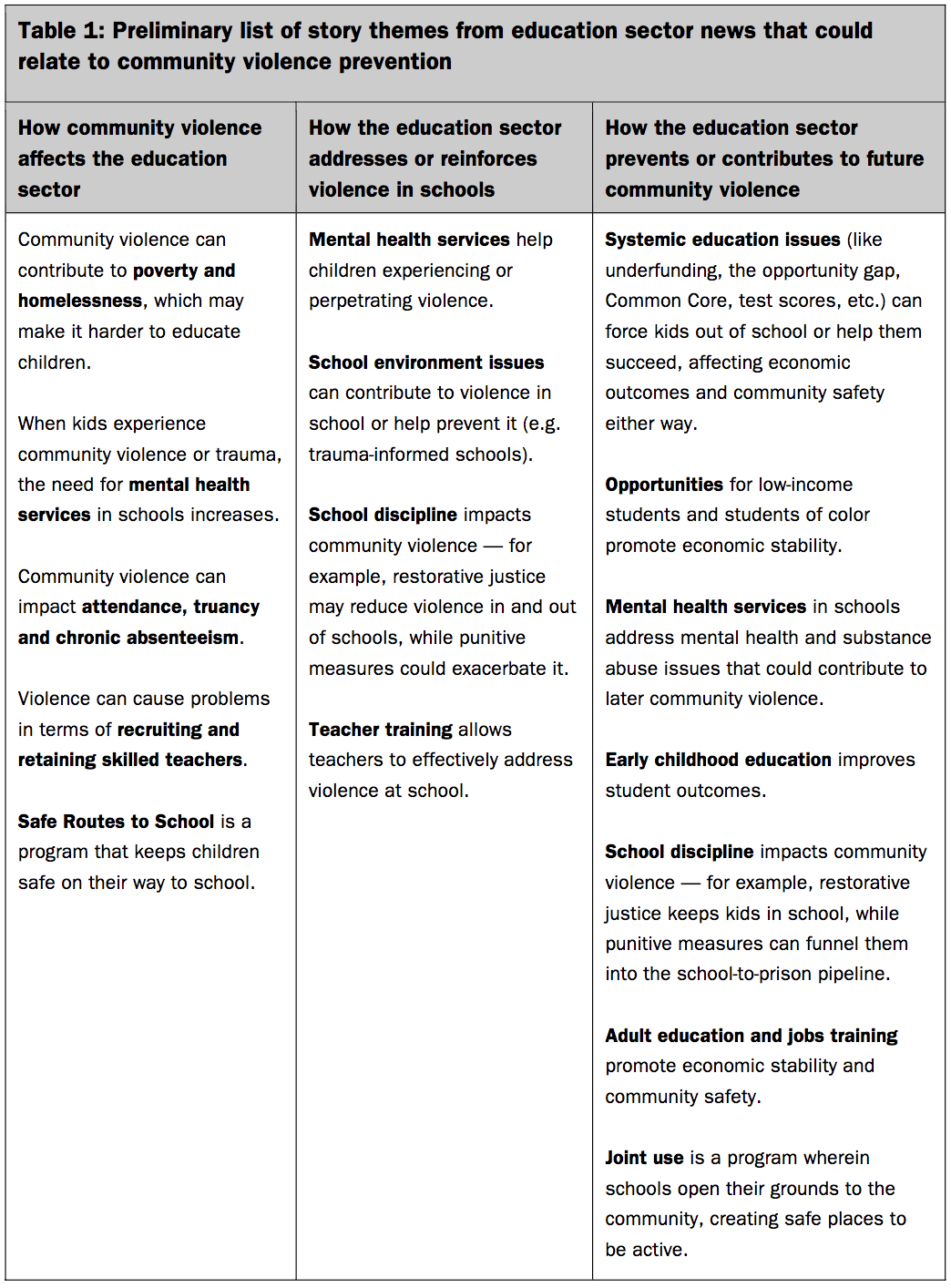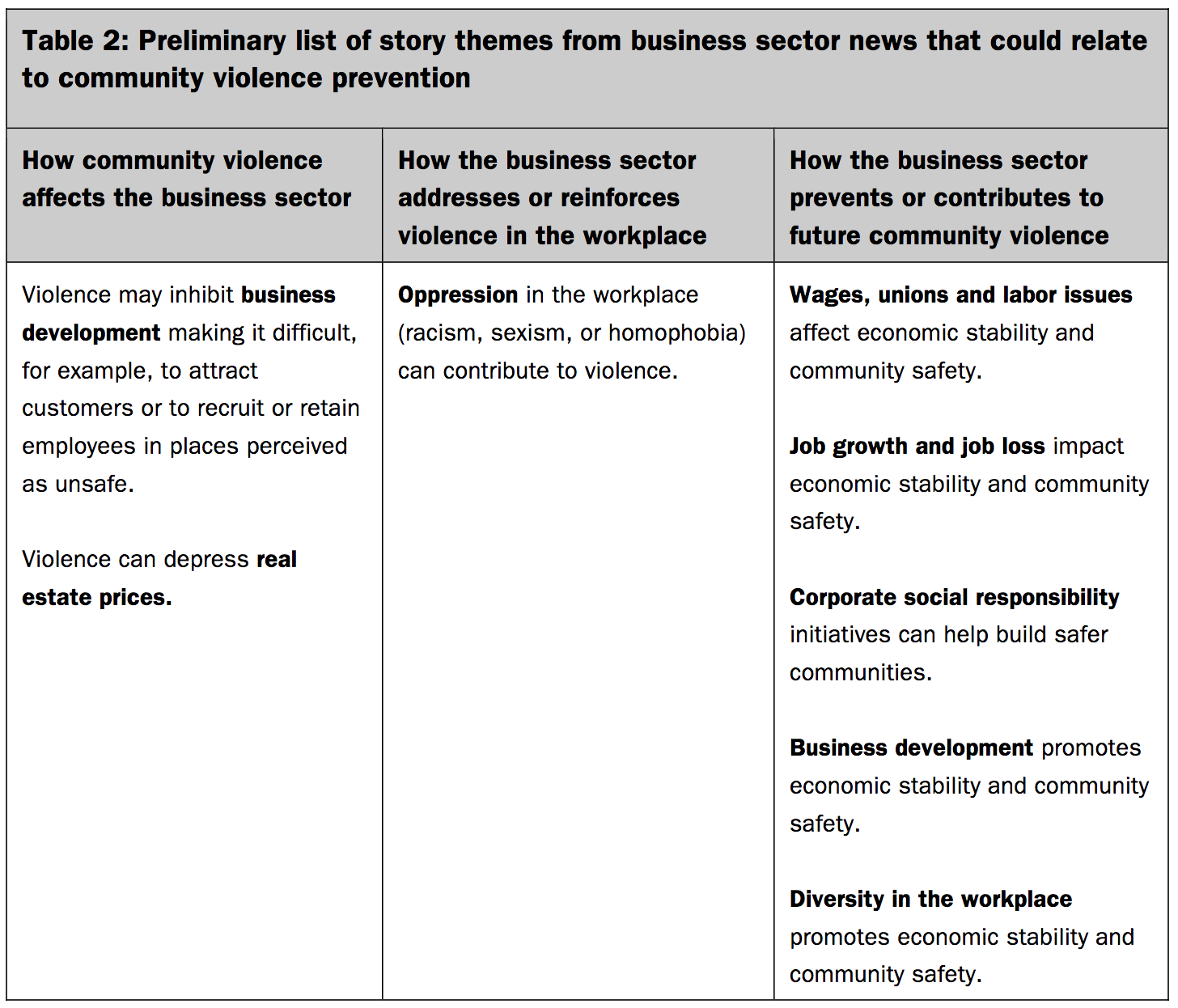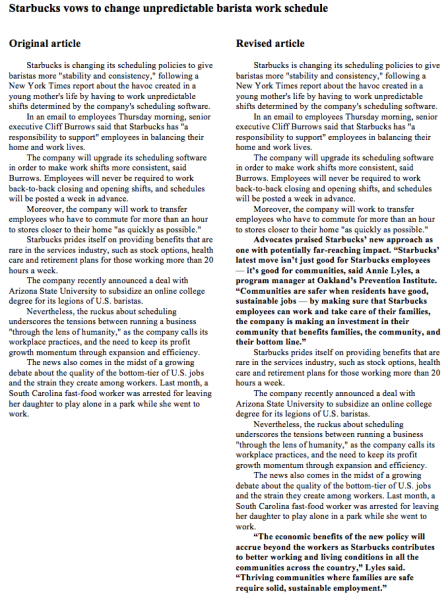Preventable or inevitable: How could news about community safety appear in California business and education coverage?
Friday, May 29, 2015It’s fair to say that we are all familiar with violence. We see it reported in the news, and many of us have experienced it firsthand. In spite of our personal and mediated experiences, however, it can be difficult to understand larger patterns of violence at the community level and harder still to understand who can end it, and how.
Community violence (defined as “intentional acts of interpersonal violence committed in public areas by individuals who are not intimately related to the victim”1) happens when complex social issues like poverty, structural racism, and easy access to alcohol, drugs and weapons coincide. Community violence is preventable, but it’s not always understood that way. Indeed, the public discourse often reinforces the idea that violence is inevitable, and as such, can only be addressed after the fact with punitive criminal justice responses.
News coverage helps us peer into that discourse: The public understands violence (apart from personal experience) through the filter of what journalists think is important to report and what publishers think will sell. News coverage then sets the agenda and tone for debates regarding public policies about violence (as well as other issues) that shape communities.2-6
News coverage of community violence may discourage positive action and reinforce assumptions that the problem is intractable when it obscures the interconnections among violence and various sectors of our society. Comprehensive violence prevention is a multi-sectoral effort that involves not only criminal justice, but also health care, schools, businesses, public health, youth-serving organizations and other groups. Typically, news coverage reflects only criminal justice perspectives7, 8 and ignores the voices and views of other stakeholders. The larger social and economic context, and the many stakeholders that are part of it, must be included if community violence is to be truly understood as a preventable problem. Those connections could be made in stories about crime and violence, but they could also be made in the business pages, in education news, or in stories about any sector that has a role to play in preventing violence.
It’s reasonable to expect that news coverage about different sectors include information about violence because we know that other sectors are affected by community violence. We wanted to know: Do discussions about or depictions of community violence and safety appear in business or education stories? Though violence affects every sector, we specifically examined the business and education sectors for this preliminary analysis. We know that community violence can interfere with employee productivity and retention, and it interrupts students’ learning and attendance.9 At the same time, these sectors play an important role in preventing violence and building safe communities. Businesses, for example, can promote community safety by providing economic opportunities and reducing poverty a significant risk factor for community violence.9 The education sector, including the schools where a community’s children spend most of their days, plays an essential role in youth development, which supports safe communities.10
If community violence isn’t explicitly addressed in articles from these sectors, where could violence prevention or community safety appear in news about business and education? What are the existing opportunities in the news to demonstrate the role those sectors could play in preventing community violence and building safer, stronger communities?
What we did
To identify stories where community violence prevention could appear in the business and education sections, we adapted our usual content analysis methodology not only to explore what appeared in business and education stories already but also to assess where violence and safety could logically be included.
Developing a coding protocol
Identifying relevant business and education themes
We first read multiple samples of business and education stories from California newspapers to develop a list of common story themes in those sections that could relate to systemic causes and effects of community violence and safety. We further refined the list by reviewing selected literature on business11-13 and education14-17 news framing. We also had in-depth conversations with education and journalism professionals and communication consultants who work with the business sector.
We identified 16 preliminary themes that appeared in education articles that could relate to community violence prevention. We also identified eight preliminary themes that appeared in business stories that could connect with community safety.
Creating a tool for analysis
We mapped the 24 themes against a modified version of the Haddon Matrix, a tool developed in the 1970s to assess points of intervention that could prevent injury before, during and after a car crash,18 which has since been used to address a number of public health and safety issues.19 The Haddon Matrix helped us assess how different themes in business and education news could connect to community violence prevention before, during or after violence might occur (see Tables 1 and 2). We asked:
- Which themes relate to how community violence affects the business and education sectors?
- Which themes relate to how the business and education sectors reinforce or mitigate violence or promote safety within each sector?
- Which themes relate to how those sectors could prevent or contribute to future community violence?
For example, education coverage sometimes included stories about high school dropout rates. Failure to complete high school is a risk factor for economic instability and contact with the criminal justice system,20 so ensuring that students graduate is one way that the education system can improve community safety. An article reporting on high school graduation rates might make that connection to violence explicitly, or it might not. If the article did mention the connection, we would note that explicit mention of violence prevention. If not, we would note that the article included themes relating to how education can prevent future community violence.
Similarly, articles about real estate prices occasionally appeared in the business section. High levels of community violence can depress neighborhood real estate prices,21 which could be mentioned explicitly in business articles. We noted if the article included the connection, and if it did not, we noted that the theme was present.
Selecting and coding a sample
Using a constructed week sampling methodology,22, 23 we collected all stories from the business and education sections, as well as all those tagged “business” or “education” in the Nexis database, from five major California newspapers (the Contra Costa Times, The Sacramento Bee, the Los Angeles Times, the San Jose Mercury News and the San Francisco Chronicle).a We analyzed newspapers because, although new media platforms are changing the way news is gathered and reported, as well as how people consume the news, newspapers and their online versions continue to set the news agenda and influence debates around public policy.24
What we found
We found 171 education articles and 310 business articles published in 2014. Due to the high volume of business stories, we randomly selected half of the business stories to code; for the analysis below, we weighted the results from business stories to restore the representation of the sample. After we discarded the articles that were not substantively about education or business (for example, a community calendar that appeared in the education sample because it listed an event to be held in a high school gymnasium, or an article about community politics that was tagged “business” because it mentioned the Chamber of Commerce in passing), we had 220 business articles and 126 education articles to code.
Education news
Community violence occasionally appears in education coverage.
Three articles, all from the education sections of newspapers, explicitly discussed the impact of community violence on students,25, 26 especially young men of color,27 and how schools around California are addressing that impact. A fourth story addressed the role of adult education programs for previously incarcerated residents in reducing recidivism and criminal behavior.28
Many more education stories could explicitly include community safety.
Though they did not explicitly reference community violence, more than 40% (56 articles) of relevant education stories contained themes that related to causes of or solutions to community violence.
The remaining stories were profiles of specific students or teachers, stories about school athletics, or stories about construction projects within school districts.
Figure 1: What themes related to community violence appeared in California education news?
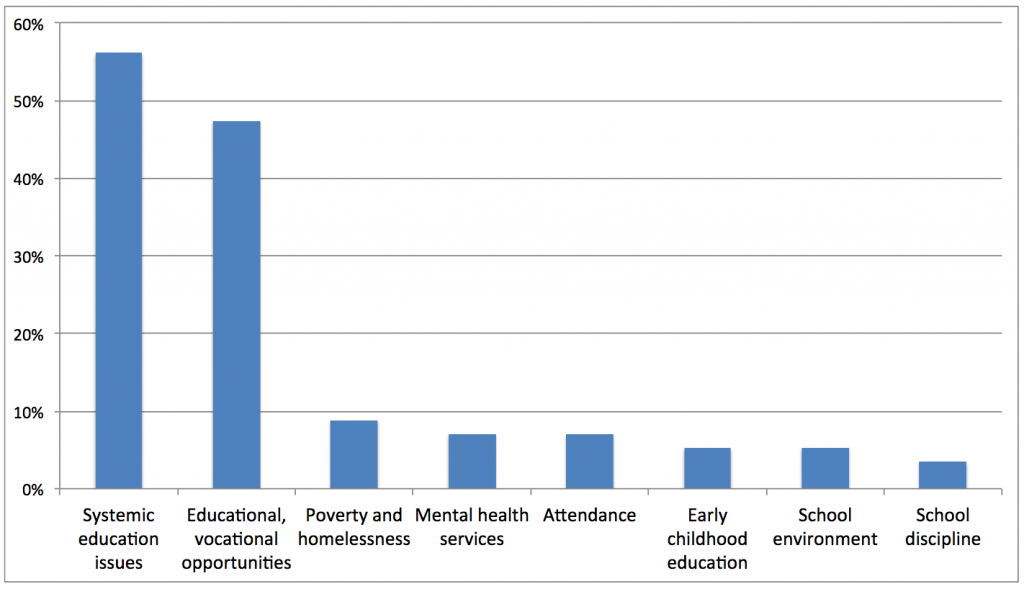
The themes that appeared most often related to how the education sector can help prevent future community violence and build safe communities for students and their families (see Figure 1b). The most common themes related to violence prevention were about systemic education issues that could force students out of school, or help them succeed, with implications for students’ economic success and, ultimately, for community safety. The second most prevalent theme in education stories was opportunities, such as special classes or discounted community college tuition, for low-income students and students who might otherwise be unable to complete school or attend college. Opportunities like these could increase school retention rates and ultimately decrease community violence.
Many of these stories could build on these themes to explicitly connect with community safety and violence prevention. For instance, one education story focused on Oakland school superintendent Antwan Wilson’s plans to raise the district’s graduation rate. Wilson observed, “[W]e don’t have all our kids in career pathways, and all our students don’t have personalized learning plans” and concluded, “This plan is about providing quality schools in every neighborhood.”29 The article goes into detail about how students and teachers will benefit and, with just a few questions to the right sources, could have gone further to illuminate how the community as a whole will benefit as well.
Another education article focused on the innovative work of a community college professor to develop applied math classes that would help improve graduation rates for African American and Latino students.30 Raising graduation rates can reduce community violence by keeping students connected to school and on a path to graduation and eventually good jobs. A few sentences in that story could have highlighted the broader benefits that accrue for the whole community when students complete high school including benefits like violence prevention and safety. Similarly, stories about teacher training and retention (for example, union issues, wage disputes or training programs) could report that the consistent presence of caring adults in the lives of young people is key to community safety. Consequently, anything that enhances teachers’ ability to forge stable, long-term relationships with their students ultimately helps lay the foundation for safe and healthy communities.
Business news
Business news does not include community safety, but it could.
We did not find any business stories that addressed community violence explicitly. However, approximately one-quarter (58 articles) of relevant business articles contained themes that could easily connect with community violence or prevention; most of these themes related to how business sector actions can support or undermine community employment, economic stability and, ultimately, communities’ long-term safety.
Figure 2: What themes related to community violence appeared in California business news?
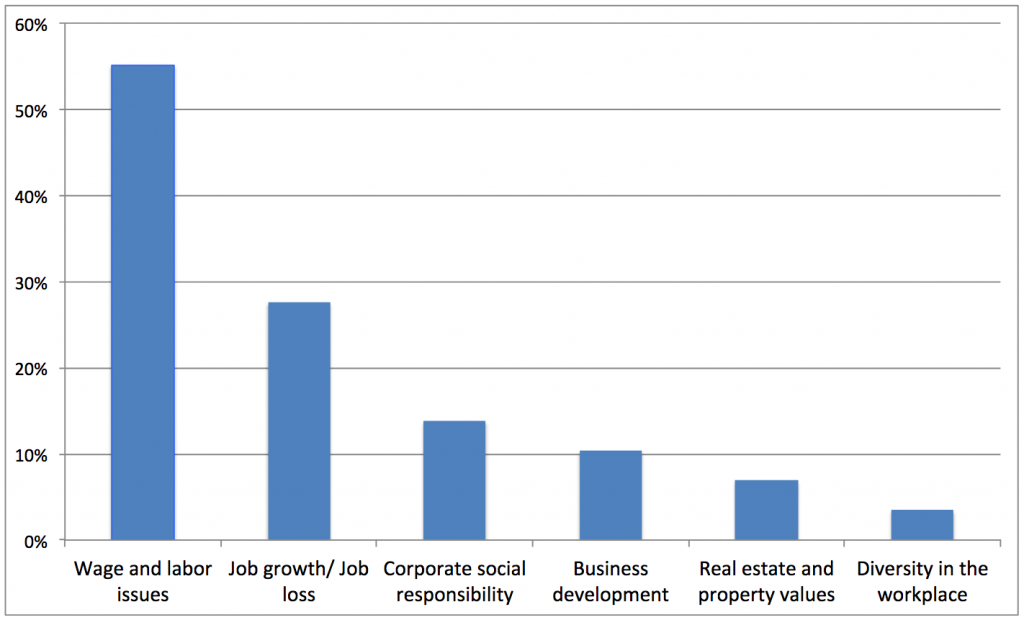
The most common themes in business stories were wages and labor issues (see Figure 2c), which can affect community members’ ability to maintain stable employment and quality of life. For example, one typical article detailed Starbucks’ efforts to change its scheduling policies to give baristas more “stability and consistency.”31 Reporters could take this idea further by asking additional sources about how stable employment affects community safety (see Figure 3 for an example). Job growth and, conversely, unemployment both of which have important implications for the economic success of a community also appeared frequently in business stories.
Figure 3: Making community violence visible in education and business news
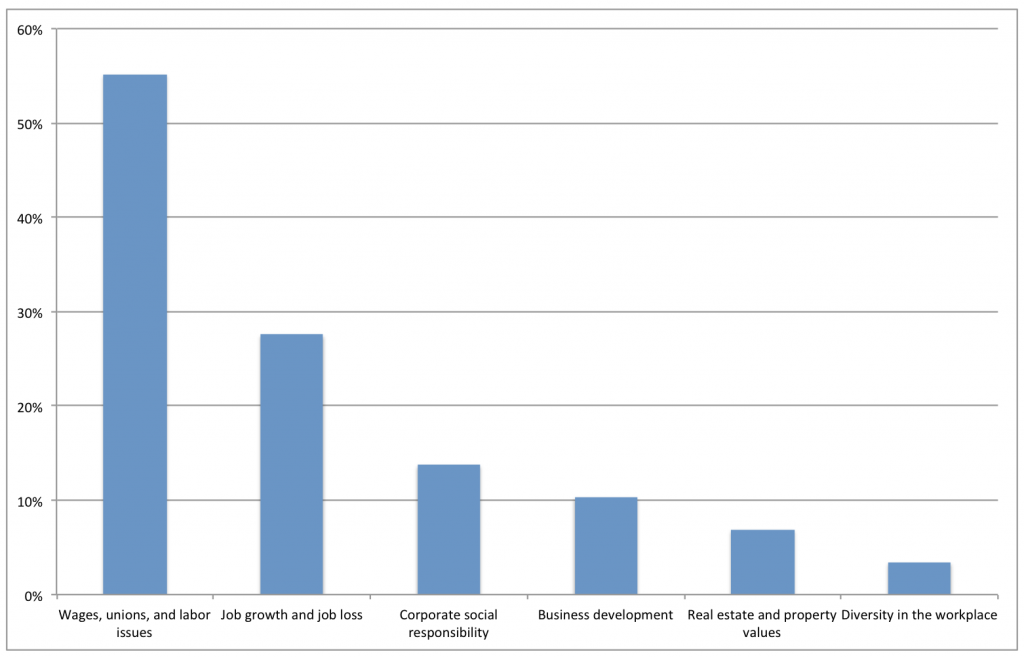
What would it look like in practice to connect community violence with education or business news? Education reporters can expand their reporting by pointing out the connection between stronger schools, higher graduation rates and improved public safety. The voices and perspectives of community health advocates can help make that connection, as can data and examples based on the real-life experiences of students and other affected community members.
In the business sector, communities are safer when residents have good, sustainable jobs. Journalists could help make the prevention link by expanding their sources beyond criminal justice representatives. Community health advocates and their allies can easily expand the frame to show the economic as well as social consequences of unstable jobs.
In the following business article, we added text in bold to illustrate how a reporter could add sources to make explicit connections with community violence.
Conclusions and next steps
Most studies of violence in the news evaluate what appears in crime reports. With this study, we broke new ground by examining not only what was in stories about community violence and safety but also what could have been included in news where violence doesn’t usually appear.
Violence prevention could involve every sector of society; for this study we focused on news from education and business. We found that:
- Community violence rarely appears explicitly in education news, and never in business news;
- There are multiple themes in both business and education news that relate to community violence prevention; and
- Many of these themes easily connect to how the business and education sectors can prevent future community violence and build or sustain safe communities.
These findings suggest distinct opportunities for both prevention advocates and reporters to expand the discourse around community safety that can help policymakers and the public better understand what prevention policies and programs should be adopted or expanded.
Journalists can expand their sources to include business and education stakeholders who can explain the connection to community safety.
The education and business communities both have a vested interest in safety and important roles to play in building safe communities. Changing the discourse around violence will require making that role, and those connections, visible by including their perspective in the public dialogue about community safety.
Journalists might need training in the risk factors for violence and on the role for education and business in building safer communities. Researchers can work with journalists to suggest new angles for reporters to investigate when they cover business or education, based on the epidemiology of violence and on evaluations of promising interventions and prevention programs.
Advocates can build capacity among violence prevention leaders to connect their work with business and education perspectives.
There are many opportunities in the news for advocates, practitioners, public health leaders and reporters to connect business and education stories with community violence prevention and draw members of those sectors into the conversation about building safe communities. Indeed, our research found that that conversation is beginning to happen, to a limited extent, in education news.
Since business and education leaders are not often part of violence prevention conversations and related work, it will be important to forge relationships with them to develop shared goals and communication priorities. Training and capacity building will be critical to inform advocates, practitioners and other community leaders about these opportunities and how they connect with work that is already happening at the community level around violence prevention. This training will shape their work to raise the profile of violence as a preventable issue in which the entire community, including the business and education sectors, has a stake. For example, if community members are advocating for specific violence prevention policies, they could explain how those policies will connect to business or education.
Community violence doesn’t happen in a vacuum and neither can the discourse around how to end it. As prevention advocates and journalists alike get better at including all the relevant stakeholders in reporting on community safety, we will see a shift in the discourse that will lead to more effective policies and programs and, finally, safer communities.
Related research
Preventable or inevitable: How do community violence and community safety appear in California news?
Acknowledgments
This paper was prepared by Pamela Mejia, MS, MPH; Laura Nixon, MPH; Fernando Quintero; and Lori Dorfman, DrPH.
This work was funded by the Northern California Kaiser Permanente Community Benefit Department. We thank the staff of the Prevention Institute, especially Annie Lyles, Rachel Davis and Lisa Parks for their feedback and guidance in the development of this study. For their invaluable insights, we especially thank Louis Freedberg and the staff of EdSource, Chris Soderquist of Pontifex Consulting, and Dr. Howard Pinderhughes of the University of California, San Francisco, School of Nursing. Thanks to Heather Gehlert for copy editing.
Endnotes
a We analyzed each article in our sample for the presence or absence of the community safety-related themes we identified. Before coding the full sample, we used an iterative process and statistical test to ensure that coders’ agreement wasn’t occurring by chance.
b For a list of all of education themes we coded for, including those that did not appear in the sample, see Table 1.
c For a list of all of business themes we coded for, including those that did not appear in the sample, see Table 2.
References
1. Community violence. (2015). The National Child Traumatic Stress Network. Available at: http://www.nctsn.org/trauma-types/community-violence. Accessed May 11, 2015.
2. Dearing J.W. & Rogers E.M. (1996). Agenda-setting. Thousand Oaks, CA: Sage.
3. Gamson W. (1992). Talking politics. New York, NY: Cambridge University Press.
4. McCombs M. & Reynolds A. (2009). How the news shapes our civic agenda. In: J. Bryant & M.B. Oliver, (Eds). Media effects: Advances in theory and research. New York, NY: Taylor & Francis. p. 1-17.
5. McCombs M. & Shaw D. (1972). The agenda-setting function of mass media. Public Opinion Quarterly; 36(2): 176-187.
6. Scheufele D. & Tewksbury D. (2007). Framing, agenda setting, and priming: The evolution of three media effects models. Journal of Communication; 57(1): 9-20.
7. Stevens J. (1997). Reporting on violence: A handbook for journalists. Available at: https://www.bmsg.org/pcvp/INDEX.SHTML. Accessed May 28, 2014.
8. Stevens J. (2001). Reporting on violence: New ideas for television, print and web. Berkeley, CA: Berkeley Media Studies Group.
9. Davis R. & Tsao B. (2014). Multi-sector partnerships for preventing violence: A guide for using collaboration multiplier to improve safety outcomes for young people, communities and cities. Oakland, CA: Prevention Institute.
10. Wilkins N., Tsao B., Hertz M., Davis R., & Klevens J. (2014). Connecting the dots: An overview of the links among multiple forms of violence. Atlanta, GA: National Center for Injury Prevention and Control, Centers for Disease Control and Prevention. Oakland, CA: Prevention Institute.
11. McGrother C. (1987). Business newes coverage in national daily news: A content analysis. Business Information Review; 3(4): 22-31.
12. An S.-K. & Gower K. (2009). How do the news media frame crises? A content analysis of crisis news coverage. Public Relations Review; 35: 107-112.
13. Carroll C. (2004). How the mass media influence perceptions of corporate reputation: Exploring agenda-setting effects within business news coverage. University of Texas at Austin.
14. Tamir E. & Davidson R. (2011). Staying above the fray: Faming and conflict in the coverage of education policy debates. American Journal of Education; 117(2): 233-265.
15. Cohen J. (2010). Teachers in the news: A critical analysis of one U.S. newspaper’s discourse on education, 2006-2007. Discourse: Studies in the cultural politics of education; 31(1): 105-119.
16. Thomas S. (2003). ‘The trouble with our schools’: A media construction of public discourses on Queensland schools. Discourse: Studies in the cultural politics of education; 24(1): 19-33.
17. Hogan L. (2013). Public schools in crisis: A content analysis of news framing since No Child Left Behind. Columbia, MO: University of Missouri.
18. Haddon W. (1972). A logical framework for categorizing highway safety phenomena and activity. Journal of Trauma; 12: 193-207.
19. Barnett D., Balicer R., Blodgett D., Fews A., Parker C., & Links J. (2005). The application of the Haddon Matrix to public health readiness and response planning. Environmental health perspectives; 113(5): 561-566.
20. Dillon S. (2009, October 8). Study finds high rate of imprisonment among dropouts. The New York Times. Available at: http://www.nytimes.com/2009/10/09/education/09dropout.html?_r=0. Accessed May 13, 2015.
21. The Center for American Progress. (2012). The economic benefits of reducing violent crime: A case study of 8 American Cities. Available at: http://www.scribd.com/doc/97451505?secret_password=1uh2sc5ftnjfn4px5rqe. Accessed May 13, 2015
22. Riffe D., Aust C., & Lacy S. (1993). The effectiveness of random, consecutive day and constructed week sampling in newspaper content analysis. Journalism Quarterly; 70(1): 133-139.
23. Luke D., Caburnay C., & Cohen E. (2011). How much is enough? New recommendations for using constructed week sampling in newspaper content analysis of health stories. Communication Methods and Measures; 5(1): 76-91.
24. Sasseen J., Olmstead K., & Mitchell A. (2013). Digital: As mobile grows rapidly, the pressures on news intensify. In The Pew Center Project for Excellence in Journalism. The state of the news media 2013: An annual report on American journalism. Available at: http://stateofthemedia.org/2013/digital-as-mobile-grows-rapidly-the-pressures-on-news-intensify/. Accessed January 13, 2014.
25. Frey S. (2014, February 16). Nine-hour school day is the norm and a national model at Oakland middle school. Contra Costa Times. Available at: http://www.contracostatimes.comews/ci_25147818ine-hour-school-day-is-norm-and-national. Accessed May 13, 2015.
26. Blume H. (2014, August 13). LAUSD opens doors to young Central American immigrants. Los Angeles Times. Available at: http://www.latimes.com/local/education/la-me-lausd-immigrants-20140814-story.html – page=1. Accessed May 13, 2015.
27. Tucker J. (2014, March 12). Oakland program for black males on White House radar. San Francisco Chronicle. Available at: http://www.sfgate.com/education/article/Oakland-program-for-black-males-on-White-House-5308523.php. Accessed May 13, 2015.
28. Anderson C. (2014, December 26). North Sacramento school puts ex-offenders on road to middle-class jobs. Sacramento Bee. Available at: http://www.sacbee.comews/business/biz-columns-blogs/cathie-anderson/article5038422.html. Accessed May 13, 2015.
29. Oakley D. (2014, November 18). Oakland Schools chief outlines plan to raise graduate rate, make teachers feel more appreciated. Contra Costa Times. Available at: http://www.contracostatimes.com/breaking-news/ci_26963760/oakland-schools-chief-outlines-plan-raise-graduation-rate. Accessed May 13, 2015.
30. Burgarino P. (2014, February 16). Los Medanos College’s unique math program boosts students’ probability of success. Contra Costa Times. Available at: http://www.losmedanos.eduews/in/snell.asp. Accessed May 13, 2015.
31. Gonzalez A. (2014, August 14). Starbucks vows to change unpredictable barista work schedules. Contra Costa Times. Available at: http://www.contracostatimes.comews/ci_26338121/starbucks-vows-change-unpredictable-barista-work-schedules. Accessed May 20, 2015.
2015 å© Berkeley Media Studies Group, a project of the Public Health Institute





